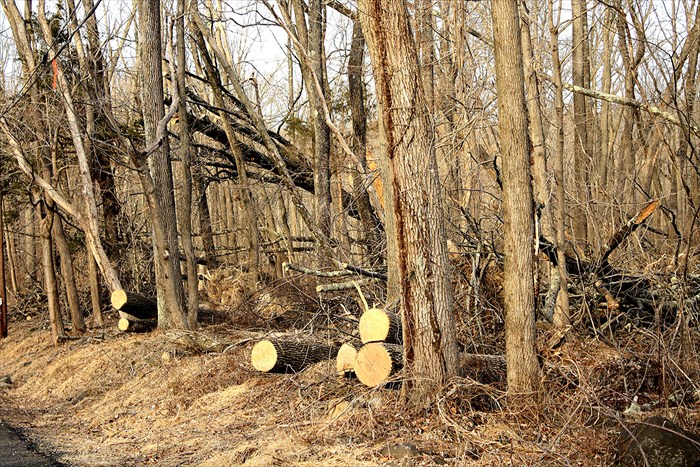Garden Diary: More light, more life ...

"It can be heartbreaking to see the natural landscape ravaged, or, as a designer, to watch something you have created be destroyed. It can even be difficult to see it change before your eyes into something you had not imagined. Perhaps for these very understandable reasons, conventional landscaping resists change ...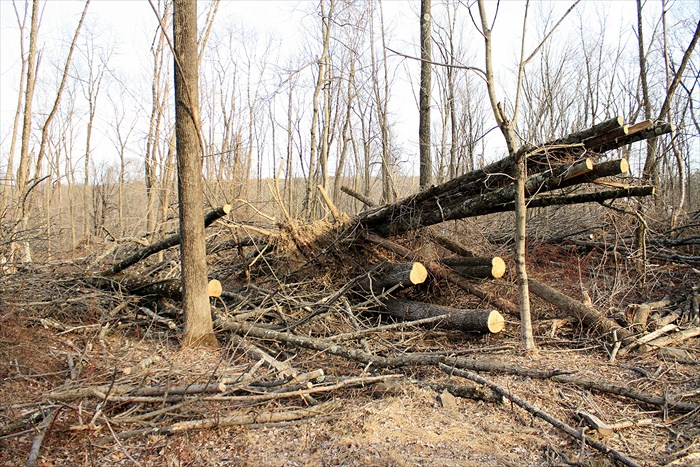 An ecologically designed landscape is, necessarily, a successional landscape growing in a disturbance regime. It is prepared for flood or fire, if these are likely events. It grows one thing and then another and then another. It is amenable to alteration and midcourse correction. In fact, it takes advantage of the natural processes of change to assemble and adjust itself." - from Principles of Ecological Landscape Design by Travis Beck
An ecologically designed landscape is, necessarily, a successional landscape growing in a disturbance regime. It is prepared for flood or fire, if these are likely events. It grows one thing and then another and then another. It is amenable to alteration and midcourse correction. In fact, it takes advantage of the natural processes of change to assemble and adjust itself." - from Principles of Ecological Landscape Design by Travis Beck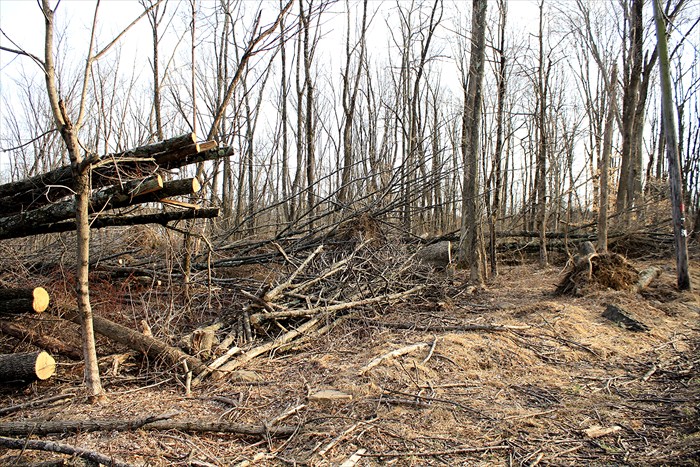 I took these pictures of the destruction along Federal Twist Road about a week ago. These are the remains of only a few of the trees that fell on our windward slope in that terrific storm in late October 2012. The trees were cut to clear the road. What you see will likely remain in place for over a century.
I took these pictures of the destruction along Federal Twist Road about a week ago. These are the remains of only a few of the trees that fell on our windward slope in that terrific storm in late October 2012. The trees were cut to clear the road. What you see will likely remain in place for over a century.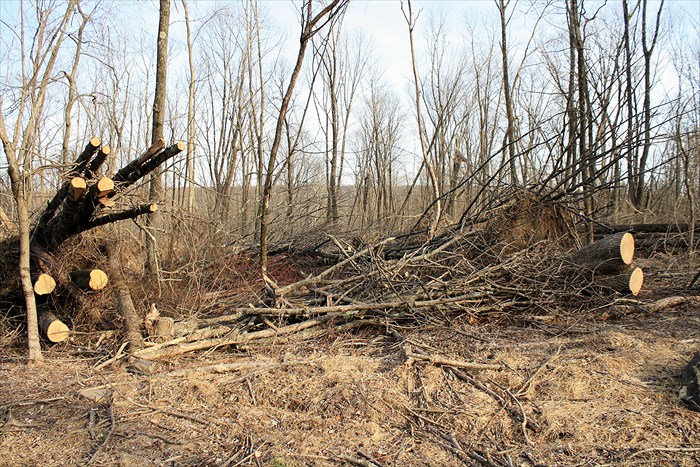 I'm not an ecologist so I only speculate that these trees may, in part at least, be the salvation of our forest.
I'm not an ecologist so I only speculate that these trees may, in part at least, be the salvation of our forest.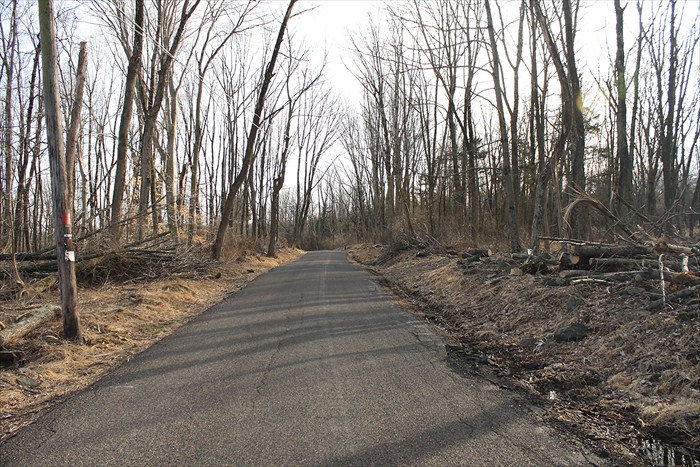 Huge numbers of deer are destroying the forest by preventing its regeneration. They eat almost everything, certainly tree seedlings. But they won't be able to get to seedlings that grow up protected by the piles of fallen trees. These pockets of refuge may enable the forest to begin to regenerate in these areas of destruction. The increase in light (the far ridge across the valley was virtually invisible before the storm thinned the trees) and disturbed soil will encourage new plants to seed and grow.
Huge numbers of deer are destroying the forest by preventing its regeneration. They eat almost everything, certainly tree seedlings. But they won't be able to get to seedlings that grow up protected by the piles of fallen trees. These pockets of refuge may enable the forest to begin to regenerate in these areas of destruction. The increase in light (the far ridge across the valley was virtually invisible before the storm thinned the trees) and disturbed soil will encourage new plants to seed and grow. I draw a parallel between this forest of destruction and my garden, which, like the forest, is subject to massive disturbance, though in the case of the garden, an annual disturbance ...
I draw a parallel between this forest of destruction and my garden, which, like the forest, is subject to massive disturbance, though in the case of the garden, an annual disturbance ...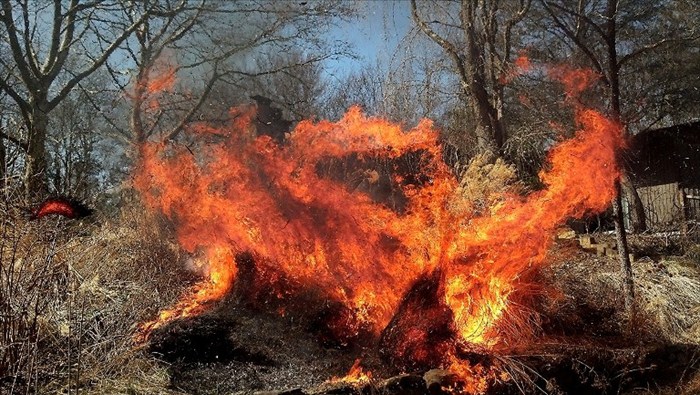 ... because I burn it, then cut what won't burn.Burning keeps down undesirable weeds and seedlings (the garden wants to return to forest, and would on its own), especially invasive Multiflora rose and other woody undesirables. And, of course, it's a much less labor-intensive way of removing several hundred pounds of dead grasses and perennials.What's left forms a natural mulch that gradually increases the organic matter in the soil and, I've discovered, encourages self-seeding of many desirable plants into soil exposed by the annual cleanup ...
... because I burn it, then cut what won't burn.Burning keeps down undesirable weeds and seedlings (the garden wants to return to forest, and would on its own), especially invasive Multiflora rose and other woody undesirables. And, of course, it's a much less labor-intensive way of removing several hundred pounds of dead grasses and perennials.What's left forms a natural mulch that gradually increases the organic matter in the soil and, I've discovered, encourages self-seeding of many desirable plants into soil exposed by the annual cleanup ... ... like these sepulchral leaden brown characters, skeletons of Inula racemosa 'Sonnenspeer', for me a most serendipitous consequence of random seeding.
... like these sepulchral leaden brown characters, skeletons of Inula racemosa 'Sonnenspeer', for me a most serendipitous consequence of random seeding.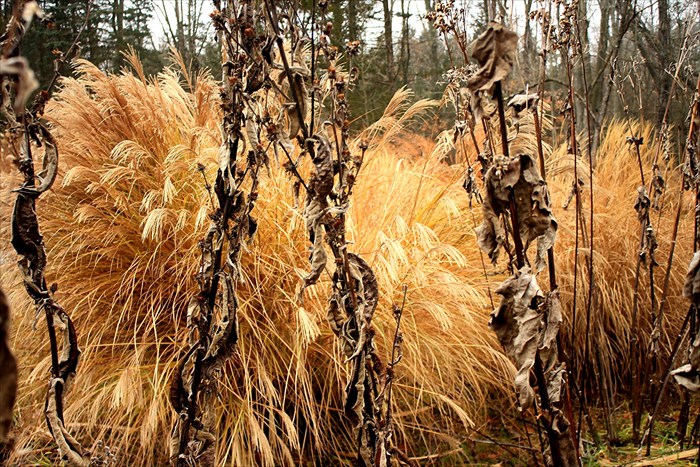 Unlike the natural ecosystem of the forest, the garden is an artificial ecosystem, made of both native and non-native plants, but plants that thrive in the existing conditions. It consists of many competing and cooperating plant communities, and has built-in resilience to adjust to change--with minimal intervention on my part.Just how resilient, I'll see this summer. The garden now must adjust to the consequences of a massive fall of white pines along its south border. (This is a separate tree fall area, not the one shown along Federal Twist Road above.)
Unlike the natural ecosystem of the forest, the garden is an artificial ecosystem, made of both native and non-native plants, but plants that thrive in the existing conditions. It consists of many competing and cooperating plant communities, and has built-in resilience to adjust to change--with minimal intervention on my part.Just how resilient, I'll see this summer. The garden now must adjust to the consequences of a massive fall of white pines along its south border. (This is a separate tree fall area, not the one shown along Federal Twist Road above.)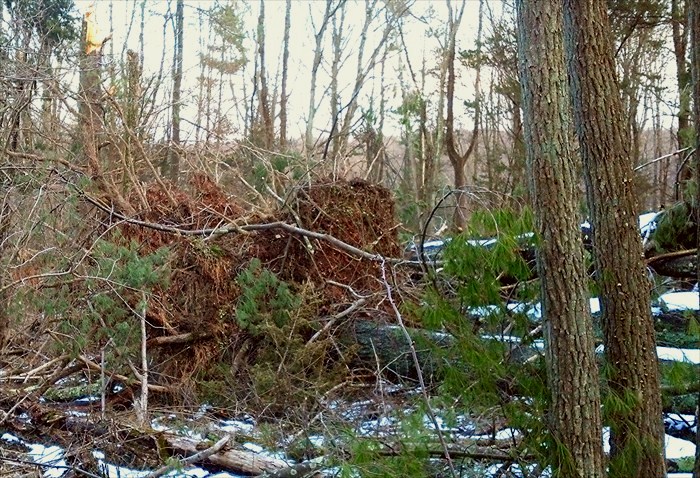 Those long, low piles of tree trunks, root plates, and tangled growth are an aesthetic challenge certainly, but with time I can adapt the garden to that visual alteration, probably even organize the mess and use it to pedagogical purpose. Much more significant, I think, will be the ecological effects in the garden proper--much more light from the new southern exposure, higher temperatures, changed aspect. What will be the effect on the existing plants used to afternoon shade, on soil moisture, on the frogs and other critters around the pond, on algae growth? Questions, questions ...This summer will begin to tell that story. I'll have to be observant, patient, and prepared to adapt.
Those long, low piles of tree trunks, root plates, and tangled growth are an aesthetic challenge certainly, but with time I can adapt the garden to that visual alteration, probably even organize the mess and use it to pedagogical purpose. Much more significant, I think, will be the ecological effects in the garden proper--much more light from the new southern exposure, higher temperatures, changed aspect. What will be the effect on the existing plants used to afternoon shade, on soil moisture, on the frogs and other critters around the pond, on algae growth? Questions, questions ...This summer will begin to tell that story. I'll have to be observant, patient, and prepared to adapt.
